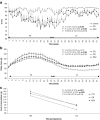Caloric restriction or resveratrol supplementation and ageing in a non-human primate: first-year outcome of the RESTRIKAL study in Microcebus murinus
- PMID: 20532988
- PMCID: PMC3063642
- DOI: 10.1007/s11357-010-9156-6
Caloric restriction or resveratrol supplementation and ageing in a non-human primate: first-year outcome of the RESTRIKAL study in Microcebus murinus
Abstract
A life-long follow-up of physiological and behavioural functions was initiated in 38-month-old mouse lemurs (Microcebus murinus) to test whether caloric restriction (CR) or a potential mimetic compound, resveratrol (RSV), can delay the ageing process and the onset of age-related diseases. Based on their potential survival of 12 years, mouse lemurs were assigned to three different groups: a control (CTL) group fed ad libitum, a CR group fed 70% of the CTL caloric intake and a RSV group (200 mg/kg.day(-1)) fed ad libitum. Since this prosimian primate exhibits a marked annual rhythm in body mass gain during winter, animals were tested throughout the year to assess body composition, daily energy expenditure (DEE), resting metabolic rate (RMR), physical activity and hormonal levels. After 1 year, all mouse lemurs seemed in good health. CR animals showed a significantly decreased body mass compared with the other groups during long day period only. CR or RSV treatments did not affect body composition. CR induced a decrease in DEE without changes in RMR, whereas RSV induced a concomitant increase in DEE and RMR without any obvious modification of locomotor activity in both groups. Hormonal levels remained similar in each group. In summary, after 1 year of treatment CR and RSV induced differential metabolic responses but animals successfully acclimated to their imposed diets. The RESTRIKAL study can now be safely undertaken on a long-term basis to determine whether age-associated alterations in mouse lemurs are delayed with CR and if RSV can mimic these effects.
Figures







Similar articles
-
Cognitive performances are selectively enhanced during chronic caloric restriction or resveratrol supplementation in a primate.PLoS One. 2011 Jan 31;6(1):e16581. doi: 10.1371/journal.pone.0016581. PLoS One. 2011. PMID: 21304942 Free PMC article.
-
Calorie restriction and resveratrol supplementation prevent age-related DNA and RNA oxidative damage in a non-human primate.Exp Gerontol. 2013 Sep;48(9):992-1000. doi: 10.1016/j.exger.2013.07.002. Epub 2013 Jul 13. Exp Gerontol. 2013. PMID: 23860387
-
Effects of chronic calorie restriction or dietary resveratrol supplementation on insulin sensitivity markers in a primate, Microcebus murinus.PLoS One. 2012;7(3):e34289. doi: 10.1371/journal.pone.0034289. Epub 2012 Mar 30. PLoS One. 2012. PMID: 22479589 Free PMC article.
-
The Potential of Resveratrol to Act as a Caloric Restriction Mimetic Appears to Be Limited: Insights from Studies in Mice.Adv Nutr. 2021 Jun 1;12(3):995-1005. doi: 10.1093/advances/nmaa148. Adv Nutr. 2021. PMID: 33271594 Free PMC article. Review.
-
[Recent anti-aging studies on caloric restriction and resveratrol].Sheng Li Ke Xue Jin Zhan. 2011 Jun;42(3):161-4. Sheng Li Ke Xue Jin Zhan. 2011. PMID: 21932511 Review. Chinese.
Cited by
-
Characterization of blood biochemical markers during aging in the Grey Mouse Lemur (Microcebus murinus): impact of gender and season.BMC Vet Res. 2012 Nov 6;8:211. doi: 10.1186/1746-6148-8-211. BMC Vet Res. 2012. PMID: 23131178 Free PMC article.
-
Molecular Liver Fingerprint Reflects the Seasonal Physiology of the Grey Mouse Lemur (Microcebus murinus) during Winter.Int J Mol Sci. 2022 Apr 12;23(8):4254. doi: 10.3390/ijms23084254. Int J Mol Sci. 2022. PMID: 35457071 Free PMC article.
-
Convenience polyandry or convenience polygyny? Costly sex under female control in a promiscuous primate.Proc Biol Sci. 2012 Apr 7;279(1732):1371-9. doi: 10.1098/rspb.2011.1326. Epub 2011 Oct 5. Proc Biol Sci. 2012. PMID: 21976684 Free PMC article.
-
Survival is reduced when endogenous period deviates from 24 h in a non-human primate, supporting the circadian resonance theory.Sci Rep. 2020 Oct 22;10(1):18002. doi: 10.1038/s41598-020-75068-8. Sci Rep. 2020. PMID: 33093578 Free PMC article.
-
Diet and aging.Oxid Med Cell Longev. 2012;2012:741468. doi: 10.1155/2012/741468. Epub 2012 Aug 13. Oxid Med Cell Longev. 2012. PMID: 22928085 Free PMC article. Review.
References
Publication types
MeSH terms
Substances
LinkOut - more resources
Full Text Sources
Medical
